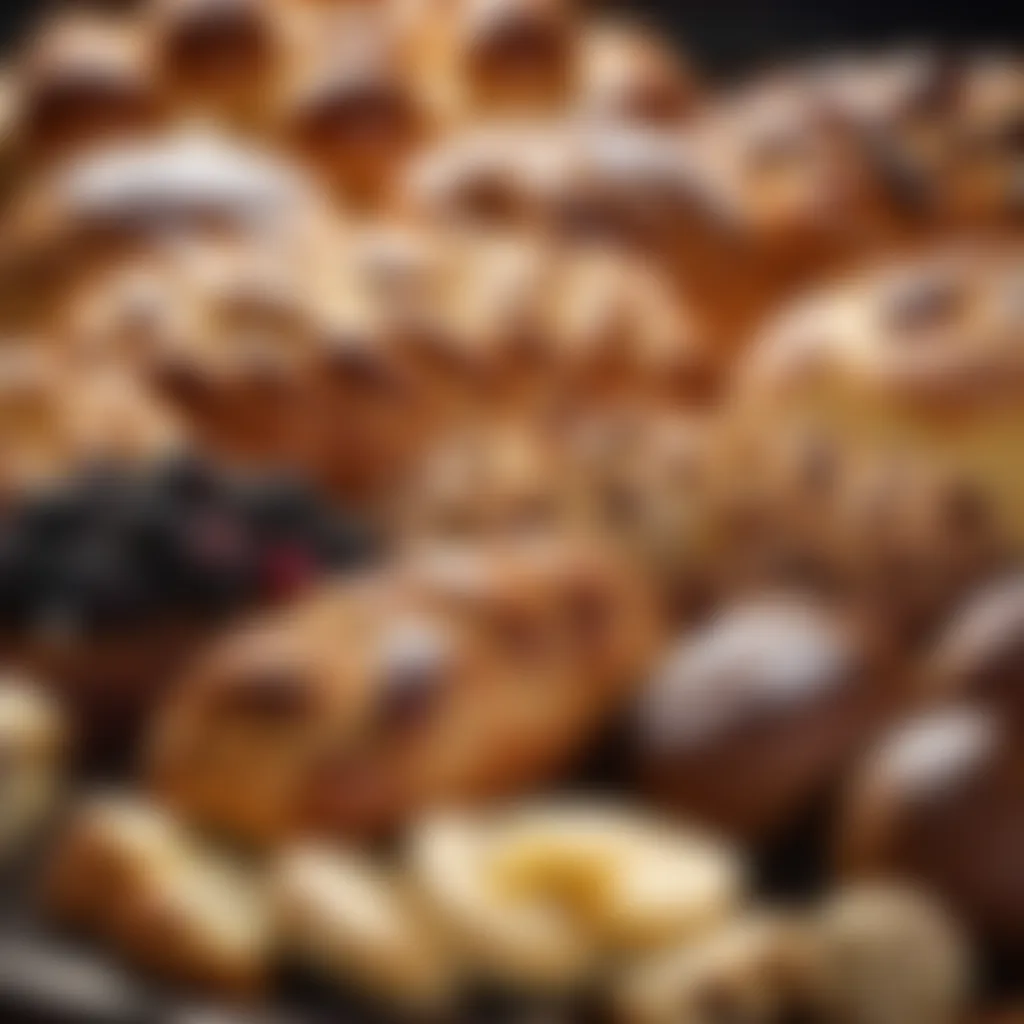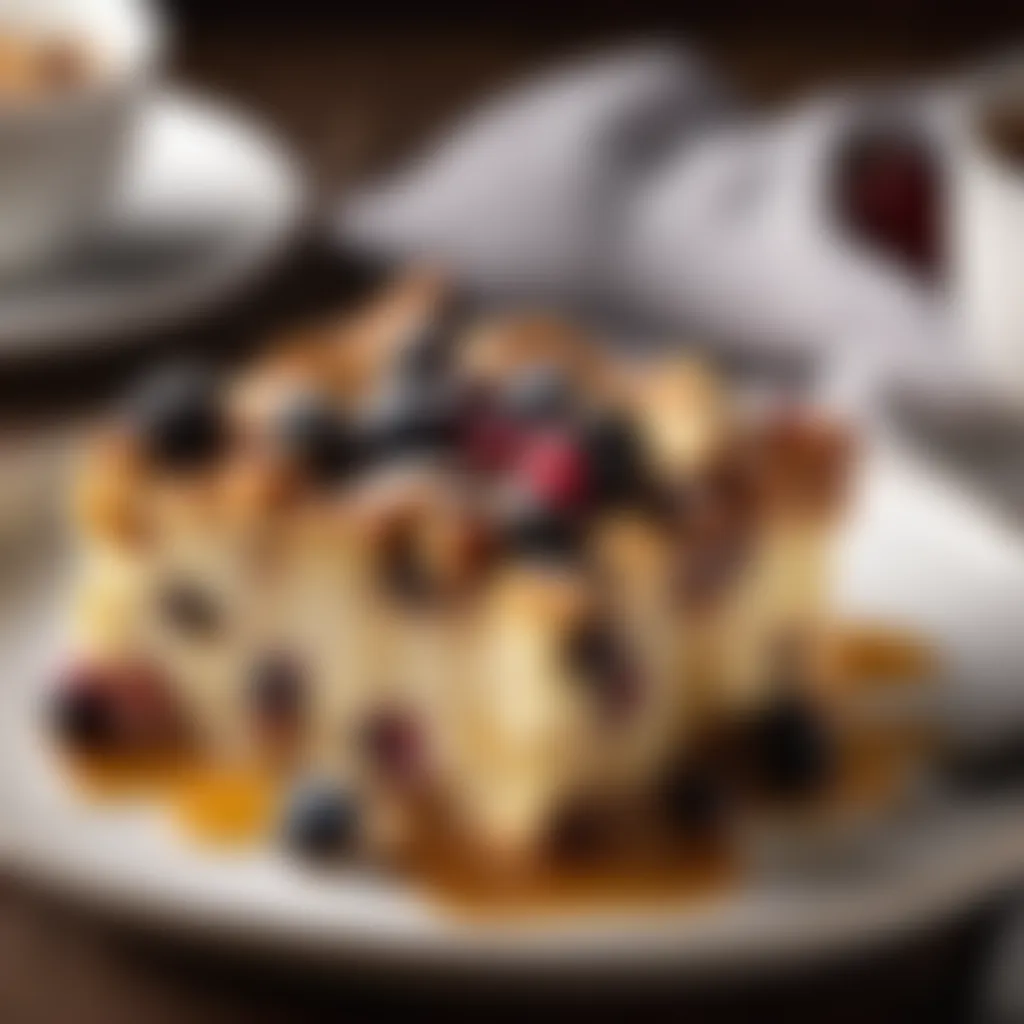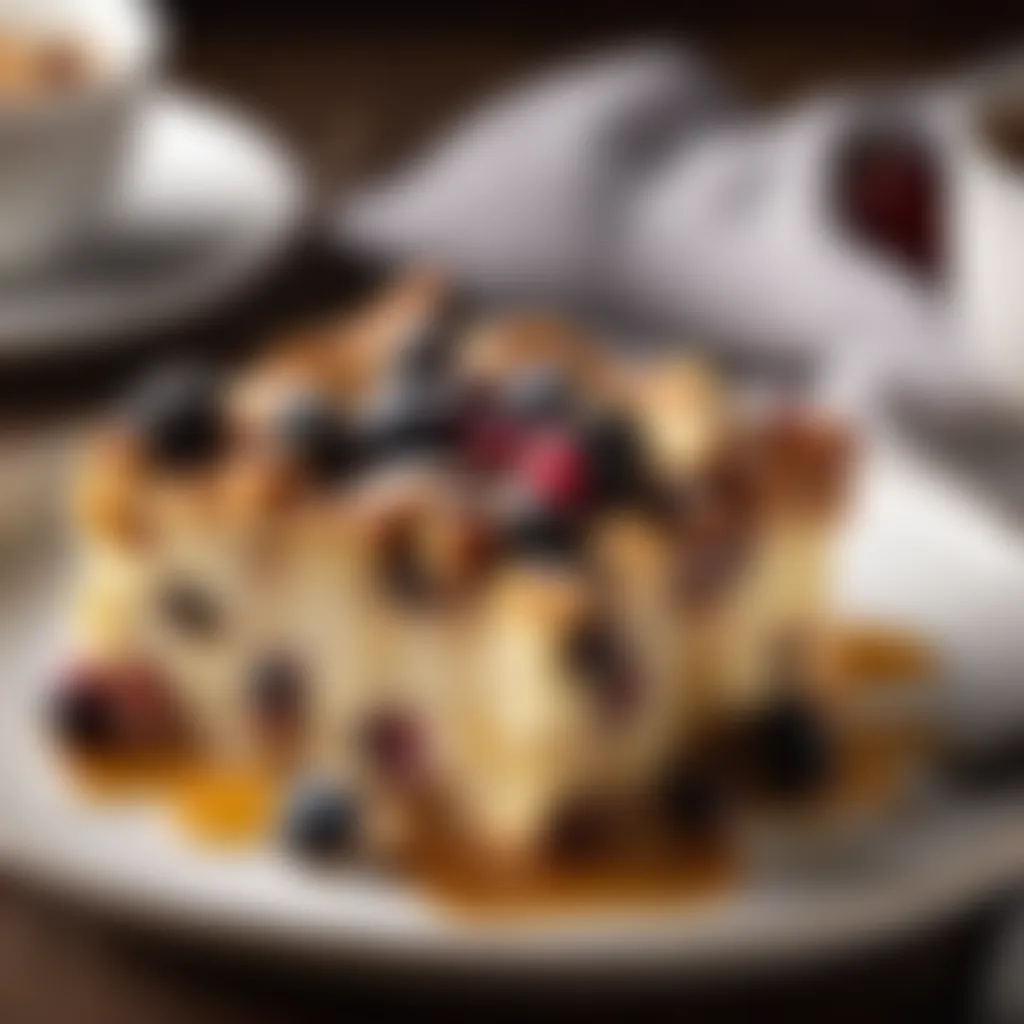Mastering Bread Pudding: Tips for a Perfect Dessert


Intro
Bread pudding, a classic dish often relegated to the sidelines, possesses a richness and depth that can easily turn it into the star of any dessert table. It's not just a means to use up leftover bread; it is, in fact, a canvas for culinary creativity. Many might overlook it, but those who take the time to master the art of crafting this layered delight find it's worth every bit of effort.
In crafting your own delectable bread pudding masterpiece, several key components stand out—proper ingredient selection, precise preparation techniques, and a flair for innovative flavor combinations. This guide will take you step by step through the process from gathering your ingredients to savoring that first bite.
Ingredients:
Before you roll up your sleeves and get your chef's hat on, let’s dive into what you’ll need to get started on your bread pudding journey. Here’s a straightforward list of ingredients, complete with the measurements to ensure the process flows smoothly:
- Bread (preferably stale): 6 cups, torn into bite-sized pieces
- Whole milk: 3 cups
- Heavy cream: 1 cup
- Granulated sugar: 3/4 cup
- Eggs: 5 large
- Vanilla extract: 2 teaspoons
- Ground cinnamon: 1 tablespoon
- Nutmeg: 1/2 teaspoon
- Salt: 1/2 teaspoon
- Optional add-ins: chopped nuts, dried fruit, or chocolate chips (1 cup)
These ingredients are foundational, but don’t shy away from experimenting. Trying different types of bread like brioche or challah can impart unique flavors and textures.
Preparation Steps:
Getting your ingredients ready is crucial. Here’s how to prep them with clarity and precision:
- Preheat your oven to 350°F (175°C). This temperature is perfect for allowing the custard to set without burning the top.
- Prepare your bread. Tear your stale bread into smaller chunks. Place these pieces into a large mixing bowl. If you’re using fresh bread, consider toasting it slightly to dry it out.
- Make the custard mixture. In a separate bowl, whisk together the eggs, whole milk, heavy cream, granulated sugar, vanilla extract, ground cinnamon, nutmeg, and salt until thoroughly combined.
- Combine bread and custard. Pour the custard mixture over the bread pieces. Let this sit for about 15 minutes or so, allowing the bread to absorb the custard. Give it a gentle stir in between.
Technical Aspects:
Maintaining the right technique is key to perfecting your bread pudding. Remember these specific details:
- Temperature: Ensure your oven is fully preheated before baking to consistently cook the dessert.
- Timing: Bake for about 45 minutes to an hour. Look for the top to be golden brown and the center should feel somewhat set but still jiggly.
- Technique: If you find the top browning too quickly, cover it with Aluminum foil to prevent burning while the inside cooks through.
Cooking Process:
Now comes the fun part. Here’s a sequential breakdown to guide you:
- Place your soaked bread mixture into a greased baking dish.
- Bake it for 45 minutes. If it seems to be browning too much, cover with foil midway.
- Check for doneness: Insert a knife into the center; it should come out clean once it’s done.
Troubleshooting Tips:
Even experienced cooks can run into hiccups. Here are some common issues and how to address them:
- Dry bread pudding: Too much bread or not enough liquid. Ensure your ratios are correct.
- Soggy pudding: Did you let it sit long enough? Either the bread didn’t absorb the custard enough or you added excess milk/cream.
- Undercooked center: Keep in mind the baking time and check for doneness near the end. Adjust oven temperature if necessary.
"While following a recipe is crucial, allowing your instincts to guide you may lead to hidden surprises in flavor and experience."
With these steps, you’re well on your way to creating a bread pudding that’s not just a dessert, but a testament to culinary mastery. Stick around, because we will explore flavor combinations and presentation methods that can elevate this dish even further.
Understanding Bread Pudding
Bread pudding, often regarded as a humble dessert, carries with it a rich tapestry of flavors and cultural significance. In this section, we’re not just dipping our toes in. We're diving headfirst into the depths of what makes this dish not only a simple staple but also an intricate delight. Understanding bread pudding enhances our ability to craft it into a masterpiece that calls for appreciation, turning basic elements into an extraordinary dessert experience.
To fully appreciate bread pudding, one must notice the interplay of textures and flavors. The contrast between a crisp top and a moist custardy center is not just luck; it’s a skillful art. As you explore this dessert, consider the choices made at each step—ingredients, preparation, and presentation—because each choice brings a unique twist to the classic.
When it comes to the benefits of understanding bread pudding, think of it as the cornerstone upon which countless variations can rise. Knowing its history and culinary context teaches us not just how to blend ingredients but why those combinations matter, allowing you to craft a pudding that resonates with your upbringing or even your travels.
With every spoonful of this delightful dish, there’s a story to be savored; a few simple ingredients can transport you to times long past, or perhaps tickle your taste buds with a modern twist.
Historical Context of Bread Pudding
Bread pudding's roots can be traced back to age-old traditions, with its genesis during the Middle Ages when no morsel of food was wasted. Bread was a precious resource, and stale bread was transformed into something special instead of being tossed aside, making it a frugal option.
In England, the dish gained prominence as a comforting dessert for families and continues to endure in various forms around the world. In France, for instance, you might encounter a version infused with spices and cream, while in the Southern United States, bourbon might make a daring appearance, highlighting the adaptability of this dish across cultures.
"Bread pudding is as old as the hills, yet remains a delightful choice for the modern palate."
Every culture adds its flair, from the Mediterranean with their regional spices to the Caribbean, where tropical fruits find their way into the mix, reflecting how bread pudding is more than just a dish; it's a canvas for creativity and tradition.
Culinary Significance
In a culinary landscape bustling with innovative desserts, bread pudding holds its own as a versatile delight that transcends mere function. It's a blank slate offering a playground for experimentation, allowing both home cooks and professionals alike to infuse their love for cooking into the very fabric of the dish.
The significance of bread pudding stretches beyond nutrition; it fulfills emotional cravings too. It's comfort food on a plate, inviting diners to reminisce about family gatherings or warm evenings spent around the kitchen table. As evenings drift into night, the scent of vanilla and cinnamon wafts through the air, evoking memories of shared experiences and delightful gatherings.
Moreover, the rising trend of sustainability in culinary practices emphasizes the importance of ingredients. Knowing how to utilize stale bread minimizes waste and maximizes enjoyment, which is absolutely the essence of cooking.
Understanding bread pudding's culinary significance not only enriches your ability to create it but also helps foster a deeper appreciation for the resources that bring this dish to life. From historical roots to personal interpretations, this dessert is a beautiful manifestation of culinary heritage.
Core Ingredients
Crafting an exceptional bread pudding is a dance of ingredients—each step taken with care, resulting in a harmony of textures and flavors. The core components of this dessert are crucial, providing both foundational structure and delightful notes that elevate the dish beyond mere sustenance. Understanding the role of each ingredient not only informs the cooking process but also enhances the final product, making it a delightful experience for all.
Selection of Bread Types
Stale vs. Fresh Bread


A common question that arises when discussing bread pudding is whether to use stale or fresh bread. Stale bread, while it may seem unappetizing at first glance, is arguably the unsung hero of this dessert. When bread becomes stale, it dries out, making it better at absorbing the custard mixture without falling apart. Imagine a sponge; a dry one absorbs liquid much better than a fresh one.
On the other hand, fresh bread offers a softer texture, leading to a lighter pudding but might not soak up the custard as effectively, which can result in a soggy bottom. Fresh bread has its place, especially when toasted beforehand, but stale truly shines when it comes to attaining the proper consistency in your bread pudding.
Types of Bread Ideal for Pudding
When it comes to the types of bread to use, the choices are numerous. Croissants are decadent, offering a rich, buttery sweetness, while brioche gives a luxurious touch that simply can’t be matched. Sourdough, with its tang, contributes a remarkable depth of flavor that’s worth exploring. Even good old-fashioned white bread can work wonders if you're looking to stick with tradition.
The key characteristic of these breads lies in their moisture and density, which affects how well they hold together during baking. However, not every bread is a suitable contender; for instance, bread with too much crust can lead to a dry and chewy pudding. Choosing wisely ensures the pudding will be a comforting, cohesive dessert rather than a confusing clump.
The Role of Custard
Milk and Cream Choices
Milk and cream bring richness and creaminess to the custard, fundamentally defining the texture and mouthfeel of bread pudding. Opting for full-fat milk or heavy cream introduces a velvety quality that's hard to resist, while using lighter options could yield a thinner custard. Someone might argue that whole milk is just enough to create the magic, but if you crave indulgence, don’t skimp on that cream!
Additionally, adding a splash of buttermilk or even flavored milk like almond can introduce a surprising twist. Of course, the downside to richness is the potential for heaviness, so finding that sweet spot can make all the difference. Essentially, the chosen dairy should complement the sweetness of the pudding, enhancing its flavor rather than weighing it down.
Eggs: Size and Freshness
Eggs act as a binding agent, bringing everything together in a delicate balance. The size of your eggs can influence the overall texture, too. Large eggs are often the standard choice in baking, but consider using extra-large or even medium eggs if that’s what you have on hand. Fresh eggs are ideal for their ability to create a richer custard, as they hold more moisture and offer better binding properties.
However, over-beating will create a frothy custard, which can lead to an airy pudding that lacks density. The trick is to whisk just enough to blend the yolks and whites, striking the right balance for a silky finish. It’s a fine line, but when found, the richness of properly treated eggs sets the tone for a pudding that feels luxurious with every bite.
Flavors and Additives
Sweet vs. Savory Additions
Once the base is established, it’s time to play with flavors. Sweet additions, such as chocolate, caramel, or dried fruits, can take your dessert to new heights. Think dried cherries, which bring a tartness that pairs beautifully with the sweetness of the bread and custard. Similarly, savory twists using items like cheese or herbs can create an unexpected but delightful bread pudding experience.
Finding the right balance hinges on the specific flavors at play. For instance, incorporating a pinch of salt can amplify sweetness, making it a delicious dance on the palate. However, going too far with savory can shift the dish from dessert to an odd side—understanding the flavor balance is key.
Herbs and Spices
Adding herbs and spices can elevate the pudding, infusing it with warmth and complexity. A dash of cinnamon or a sprinkle of nutmeg adds that cozy flavor, harkening back to simpler times around the kitchen table. Fresh herbs like rosemary or thyme might seem unusual for a dessert but can add an unexpected depth that intrigues.
While herbs often bring freshness, spices serve to enhance existing flavors. However, too much spice can overwhelm the delicate balance you’ve achieved. The goal is to enhance, not overshadow, allowing the base flavors to sing while complementing them with subtle undertones.
Preparation Techniques
Preparation techniques play a crucial role in the creation of bread pudding. The way in which ingredients are combined can significantly impact the final texture and flavor of the dish. Proper techniques ensure that every bite offers a delightful balance of custard and bread, creating a dessert that can almost be described as sinfully good. The following sections will delve into layering methods and custard mixing strategies, both vital to crafting a successful pudding.
Layering Techniques
Alternating Ingredients
When it comes to layering ingredients in bread pudding, alternating plays a significant role. This technique involves placing different components in a rhythmic fashion, often alternating between layers of bread and custard or adding fruits and nuts into the mix. By doing this, the final product attains a uniform distribution of flavors, rather than an overwhelming burst of one ingredient in a particular bite.
The key characteristic here is balance. Utilizing the alternating technique allows the rich, creamy custard to seep into the bread while simultaneously offering hints of sweetness from fruits or crunch from nuts. This approach is especially beneficial when you're looking to surprise your taste buds with an array of textures in one delightful dessert.
One unique feature of this method is its flexibility; it suits various flavors from chocolate to spices. However, an important consideration is the careful construction of your layers, as improper layering could result in inconsistent flavor profiles throughout the pudding.
Optimizing Texture
Optimization of texture is another integral component when preparing bread pudding. The texture can make or break the dish—whether it be creamy, custard-like or slightly firm. A crucial aspect of this is ensuring that the bread becomes adequately saturated by the custard mixture without turning overly soggy. This balance is what leads to a pleasing mouthfeel.
Focusing on texture provides value across all baking endeavors. For bread pudding, the goal is a harmonious combination of moistness from the custard and softness of the bread. Achieving this is a popular aim among bakers who want their creation to be more than just a humble dessert.
An interesting downside to this optimization is the risk of over-soaking the bread, leading to a pudding that can fall apart when served. Therefore, expressing caution with the custard-to-bread ratio can help avoid potential issues during baking.
Custard Mixing Methods
Whisking Techniques
Whisking techniques are underappreciated, yet they serve as the backbone of a velvety custard. Using a whisk to mix your ingredients allows you to incorporate air, which enhances the texture of the custard. An effective swirl ensures that eggs blend seamlessly with milk or cream, creating a uniform mixture that promises an even bake.
The beauty of whisking lies in its simplicity. This method is accessible to both novice and experienced home cooks. However, the unique feature that sets it apart is the aeration; a good whisking can lead to a lighter pudding overall.
On the flip side, if whisking is done too vigorously, it may incorporate too much air, leading to an undesirable volume post-baking. Thus, a gentle yet thorough approach promotes a custard that is both delicious and well-formed.
Incorporating Air for Lightness
To enhance the overall lightness of your pudding, incorporating air into your custard is paramount. This technique allows for a fluffy texture once baked, providing an appealing dichotomy against the denser bread. Whisking and folding techniques in a careful manner facilitate this leveled approach, ensuring air is retained in the batter. This characteristic of incorporating air contributes positively to the overall goal of producing a decadent dessert. Many bakers appreciate this method, recognizing it sets a foundation for a pudding with a lifted spirit and unctuous texture. Nonetheless, caution is advised; over-aerating can easily lead to inconsistencies, resulting in a pudding that won’t hold its form upon slicing. Stability should never be sacrificed for the sake of lightness.
Baking Essentials
Baking essentials form the backbone of a successful bread pudding. They are not just a checklist of what to use; they play a critical role in the outcome of your dish. When the right techniques and tools are applied, a humble bread pudding can transform into a delightful creation, molded to your personal taste and preference. Emphasizing specific baking elements helps ensure you achieve the custardy, comforting texture and flavor balance that this dessert is famed for.
Choosing the Right Bakeware
Material Considerations
When it comes to bakeware, the material you choose can make a world of difference. Glass, ceramic, metal, and silicone are common options, each with its own traits. For instance, glass bakeware heats evenly, allowing for a consistent bake. However, it may take longer to reach the desired temperature compared to metal. Metal, on the other hand, offers superior heat conduction which can be great for achieving a crispier crust. Yet, it may sometimes lead to uneven cooking if not monitored carefully.
- Durability: Glass and ceramic are sturdy yet prone to chipping, while metal can warp under extreme conditions.
- Popularity: Glass and ceramic bakeware are often favored for their aesthetic appeal. They can transition from oven to table, doubling as serving dishes.
Use the unique features of these materials to your advantage. For instance, if you find yourself basting a lot, silicone can assist with non-stick properties. But be cautious, as it doesn’t conduct heat as well.
Size and Shape Impact
The size and shape of your chosen bakeware play a vital role in how evenly the pudding cooks. A deeper dish may retain moisture, leading to a denser pudding, while a shallower dish allows for more caramelization. For bread pudding, a rectangular or a round shape works best, giving enough surface area for even heat distribution.


- Versatility: A wide range of bakeware shapes can present different aesthetics and textures. Rectangles may offer more crusty edges, while deep dishes keep the inside creamier.
- Considerations: Remember, the size you select should correlate with the amount of batter. Overloading can lead to uneven baking.
Temperature and Timing
Baking bread pudding is as much about temperature as it is about timing. Finding the sweet spot between the two is crucial for achieving that smooth custardy center paired with a slight crust on top.
Preheating Importance
Preheating your oven is non-negotiable; it sets the stage for baking. A preheated oven ensures that your pudding cooks evenly from the outset, preventing the bottom from getting mushy while the top remains uncooked. It helps establish the correct environment for the milk and eggs to set properly.
- Convenience: Stepping away from the kitchen while your oven warms up might seem harmless, but it can lead to an uneven bake or puffed edges that collapse later on.
- Key Characteristic: Immediately introducing your bread pudding to heat promotes a beautiful rise. Focus on getting that oven to the right temperature before you pop in your dish.
Signs of Doneness
Knowing when your bread pudding is done baking can be tricky. The goal is for the edges to be set while the center has a slight jiggle. An undercooked pudding will not only affect flavor but can also lead to food safety issues. A good tip is to insert a knife or toothpick into the center; if it comes out clean, you’re golden.
- Texture Clues: A freshly baked pudding will be soft and springy. If the top has a golden hue and a little firmness when touched, that’s usually your cue to remove it from the oven.
- Visual Indicators: An accomplished bread pudding doesn't bubble excessively, nor does it look overly dry or cracked on top. It should present a level of confidence—smooth, and inviting.
Leverage these baking essentials to not only enhance your bread pudding experience but to also build your confidence in the kitchen. Mastery comes with practice, and tweaks in technique can lead you to discover delectable outcomes.
Innovative Variations
When it comes to bread pudding, thinking outside the box can elevate it from a simple dessert to a culinary masterpiece. Innovative variations are essential, as they allow cooks to reflect their individual tastes and creativity. By experimenting with global influences and unique flavor combinations, one can transform the classic bread pudding into something remarkable. These variations not only enhance the dish's appeal but also invite an array of textures, colors, and aromas that can dazzle the senses.
Global Influences
Regional Twists on the Classic
Bread pudding is a dish beloved across cultures, and its regional twists offer flavors that are different and fascinating. Each area brings its own character and ingredient preferences, contributing to a rich tapestry of interpretations. For instance, in France, croissant bread pudding takes advantage of buttery pastries, lending an airy lightness that can make one's mouth water. In contrast, the South has its bourbon-infused versions, adding a depth of taste that warms the heart.
The magic of regional twists lies in their adaptability. It's about infusing local flavors while respectin' the traditional elements of the pudding. A key characteristic of these variations is their cultural roots—a true representation of a locale's palate. When using specific regional ingredients, like a Mexican pan dulce, you not only pay homage to diverse cultures but also create a dish that's familiar and different all at once.
However, one must tread carefully. These twists, while enticing, can sometimes overshadow the core essence of what makes bread pudding special. The balance of integrating unique flavors without losing the traditional savory undertone can be a bit of a challenge.
Cultural Ingredients Worth Exploring
Cultural ingredients further enrich the concept of innovative bread pudding. Seeking out local or international components—like coconut milk, chai spices, or even matcha—can lead to unexpected delights. Imagine the fusion of coconut milk giving a tropical twist to the classic custard, or the aromatic embrace of chai spices lifting the vanilla softness into a fragrant journey.
The inclusion of cultural ingredients not only adds flair but also personal touch. It allows one to tell a story through food. A beneficial aspect of using these products is their versatility; many ingredients can be used across various types of bread puddings. For example, incorporating saffron in a custard makes for an elegant touch, markin’ its place on special occasion tables.
However, attention is necessary when exploring these ingredients. Some flavors may clash if not carefully balanced, and the intrinsic sweetness of the pudding can be masked. It's essential to gauge each new addition's impact on the overall flavor.
Creative Flavor Combinations
Fruits and Nuts Pairings
Pairing fruits and nuts in bread pudding creates a wholesome flavor profile that's hard to beat. Fruits like peaches, apples, or berries introduce bursts of freshness and sweetness, while nuts such as pecans or walnuts offer an earthy crunch that complements the soft texture of the pudding. For instance, the combination of apples with cinnamon offers a comforting feel reminiscent of autumn, while mixed berries contribute a vibrant splash of color and tanginess.
This pairing is widely popular, working wonderfully with both sweet and savory versions of bread pudding. Fruits and nuts are approachable and easy to find, making them a top choice for aspiring home cooks. They also provide a balance of nutrients, making the dessert feel a little less guilty. However, be cautious not to overstuff the pudding with fruit, as this could lead to uneven cooking and a soggy mess.
Chocolate and Spices
Combining chocolate and spices allows for an intriguing exploration of flavors. The foundation of a rich chocolate pudding could be elevated with fragrant spices like nutmeg, cardamom, or even cayenne for those who appreciate a kick. These flavor profiles can work wonders, much like a good marriage, adding complexity to what could otherwise be a mundane chocolate dish.
Chocolate lovers savor these contrasts, enjoying the interplay between rich sweetness and aromatic warmth. Spices can highlight the chocolate's natural depth, transforming the ordinary into the extraordinary. However, a word of caution: the balance of spice is crucial. Too much can overpower the chocolate, making the flavor clash rather than harmonize.
By venturing into innovative variations, one does not just recreate a dish but instead opens the door to creativity and a deeper appreciation for the versatile nature of bread pudding. Exploring these avenues is not merely about recipe alteration—it's about crafting a personal experience that resonates across taste and tradition.
Presenting Your Bread Pudding
When it comes to bread pudding, what you see often sets the stage for the delight taste. Presenting your creation can transform a simple dessert into a noteworthy centerpiece, making it more appealing to the eyes and mouth. The importance of presentation cannot be overstated, as it enhances anticipation and adds a layer of sophistication. A well-presented bread pudding reflects the care and artistry poured into its creation.
Presentation Techniques
Garnishing Options
Garnishing is like adding a cherry on top— it can elevate a good dish into something exceptional. When it comes to bread pudding, the right garnishes can bring color, texture, and even complementary flavors. Fresh mint leaves, a sprinkle of powdered sugar, or a swirl of caramel sauce can work wonders.
- Color Contrast: Using vibrant garnishes not only brightens up the dish but can also heighten the overall eating experience.
- Texture Overlay: A crunchy topping or creamy drizzle can introduce an exciting juxtaposition to the traditionally soft and rich pudding.
Each garnish should be purposeful; after all, too much can overwhelm the dish. Keeping it simple and tasteful tends to pay off. Think of it as the finishing touch on an already exquisite canvas.
Plating Styles
The way bread pudding is plated plays an impactful role in making it visually attractive. A rustic approach may utilize a wooden board or a simple dish that celebrates its homey qualities. Alternatively, a sleek white plate could amplify elegance.
- Layering Elements: Consider stacking slices creatively or placing them at an angle to showcase the custardy layers.
- Negative Space: Leaving some plate bare can draw attention to the bread pudding and prevent a cluttered look.
Choosing a plating style should align with the occasion, whether it be a casual family dinner or an upscale gathering. The unique feature of plating is the ability to personalize it; you can adjust based on not just flavor but the mood of the event.


Serving Suggestions
Accompaniments to Enhance Flavors
Pairing your bread pudding with the right accompaniments can do wonders. Think of your pudding as the star on a stage, and the accompaniments as the supporting cast. Vanilla ice cream, a drizzle of custard, or even a scoop of whipped cream can create a delightful fusion of flavors. Each of these selections adds another layer of richness or brightness to the dish.
- Flavor Balance: An accompaniment should harmonize with the bread pudding; for instance, creamy additions may balance a spiced pudding or citrus zest may cut through the richness.
- Texture Variety: This is where you can introduce elements like nut crunch or berry bursts, adding complexity to every bite.
However, you need to be cautious not to overpower the bread pudding. The focus should always rest on the dessert itself, allowing the complements to elevate rather than dominate.
Beverage Pairings
Finding the right beverage to accompany your bread pudding can perfectly round out the meal. A spiced apple cider or a rich coffee can often enhance the dessert's flavors, creating a multisensory experience.
- Contrasting Flavors: A hearty stout or a smooth dessert wine can bring out unexpected notes in the pudding, making the combination more intriguing.
- Temperature Play: Pairing a warm pudding with a chilled drink or vice versa can create a delightful contrast that tantalizes the palate.
Troubleshooting Common Issues
When it comes to crafting that perfect bread pudding, understanding potential pitfalls can make or break your culinary endeavor. Even seasoned cooks might encounter unexpected issues. Knowing how to troubleshoot them not only saves your dish but also enhances your overall confidence in the kitchen. From texture dilemmas to flavor discrepancies, being equipped to address these problems ensures your bread pudding comes out nothing short of delightful. Here, we dive into common challenges and how to fix them.
Texture Problems
Soggy or Dry Pudding
A bread pudding with unforeseen sogginess or dryness can lead to disappointment. Soggy pudding often stems from too much custard or insufficient baking time. It’s the kind that can make a delightful dish feel like you've waded into a marsh rather than indulged in a creamy treat. On the flip side, dry pudding results from too little custard or overbaking, leaving you with a parched texture akin to sawdust. Finding the right moisture balance is essential.
To remedy sogginess, consider the bread type you used—some absorb moisture better than others. Stale bread, for instance, can soak up custard without turning mushy. If you find yourself with dry bread pudding, a drizzling of syrup or custard before serving can revitalize it.
In summary, knowing how to adjust the moisture content is crucial for achieving that perfect bite, and both issues highlight a fundamental aspect of good cooking: balance.
Overcooked or Undercooked
Overcooked bread pudding often leaves a hard crust that could put off even the most dedicated dessert lovers. Conversely, undercooked pudding can give the dreaded raw egg taste, something best avoided at all costs. An overcooked dessert is usually the result of too high temperatures or excessive baking time, making it crumbly and dry.
To ensure proper doneness, it’s helpful to keep a close eye on the baking process. Look for a golden-brown surface and gently shake the dish; if the center jiggles slightly like a well-set jelly, you’re in good shape. This delicate balance is what elevates your dish into the realm of the delectable.
Flavor Adjustments
Balancing Sweetness
Sweetness in bread pudding can often be a double-edged sword. While a delightful hint of sweetness can please the palate, too much can be overwhelming. Striking the right ratio can make a world of difference. If your bread pudding turns out too sweet, this can mask the beautiful flavors of your chosen ingredients, such as fruits or spices.
A helpful tip is to taste your custard mixture before incorporating it into the bread. If it feels cloying, you could balance it out by adding a pinch of salt or even a splash of citrus juice, which can serve to enhance the overall flavor with a bright note.
This adjustment reflects the adaptability of bread pudding, allowing it to be tailored to individual preferences.
Improving Depth of Flavor
Sometimes, bread pudding lacks that punch of flavor that makes the dish memorable. The key here is to engage all your flavors. To improve depth, think about incorporating a mix of different ingredients. Vanilla extract, cinnamon, nutmeg, or even a bit of rum can elevate the custard, bringing complexity to your creation.
One feature that enhances depth is layering your ingredients thoughtfully. Adding fruits like raisins or even chocolate chips can bring varied textures and sweetness levels, transforming a basic bread pudding into an intricate dessert experience. Don't shy away from experimentation here—each ingredient can tell its own story, adding richness to the dish.
When it comes to flavor, take it as a personal journey. Remember, the best bread pudding tells a tale of its creation, weaving together the flavors you've chosen with care.
Final Thoughts on Bread Pudding Mastery
Mastering the craft of bread pudding is much more than just following a recipe. It's an art, one that involves weaving together history, technique, and personal preference. Each loaf of bread leads to multiple possibilities, and through careful consideration of ingredients and methods, one can elevate a simple dessert into a breathtaking experience.
When you think of bread pudding, it’s easy to overlook the subtle nuances that dictate success. A well-executed pudding should be rich yet not overly heavy. The custard must envelop the bread, soaking it just right, yet not leaving it a soggy mass. Flavors should mingle harmoniously, creating a balanced bite. Thus, understanding these components can help you navigate this culinary journey.
"Bread pudding is a reflection of one’s own sense of taste, culture, and culinary confidence."
Every time you step into the kitchen to create your bread pudding, you are also crafting your own story. There is a myriad of fillings, spices, and sauces that can be paired to suit your palate. Thus, embracing experimentation can lead to delightful surprises. Remember, even renowned chefs had to start somewhere, tweaking their recipes until they found their signature touch.
Ultimately, this article provides tools and insights that inspire confidence in crafting your bread pudding masterpiece. You'll find that each success will build upon itself, encouraging you to venture further into this delightful realm of baking.
Reflecting on Personal Experiences
Reflecting on personal experiences with bread pudding can be as meaningful as the dish itself. Think back to those moments in the kitchen, the smell of warm vanilla wafting through your home, or the eager anticipation as family gathers around the table. Maybe it was your grandmother’s cherished recipe or a unique version discovered while traveling abroad. These memories shape not just your understanding of the dish, but your approach to making it.
As you dive into your bread pudding explorations, consider:
- What flavors remind you of home? Incorporate those into your dish.
- Have you had a bread pudding that didn’t quite hit the mark? Analyze what went wrong, and use that as a learning experience.
These reflections can guide your choices as you create. You can draw inspiration from cherished moments while also paving your own path. Each pudding you bake will be an expression of both nostalgia and innovation.
Encouragement for Experimentation
Diving into the world of bread pudding invites a spirit of experimentation that is vital in culinary pursuits. Different bread types, from a crusty baguette to a soft brioche, can transform the texture and flavor of your treat. Don't shy away from trying new additions such as exotic spices or even an unexpected splash of liqueur.
Here are some ideas to spark your creativity:
- Try adding a unique twist with ingredients: Consider using ingredients like matcha for an earthy note or caramelized peaches for a sweet contrast.
- Experiment with textures: Perhaps a layer of chocolate chips or crushed nuts could add delightful crunch to your pudding.
- Play with temperature: After baking, serve your bread pudding warm with a scoop of vanilla ice cream, or chill it for a refreshing take.
Engaging with these various techniques can help you grow more comfortable and confident in your kitchen. Remember, it’s perfectly alright to hit a few bumps along the way; every chef has their tales of failure that often lead to their greatest triumphs. So, don’t hesitate to try, taste, and let your imagination run wild!







